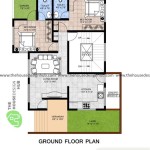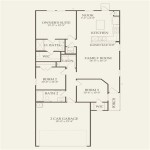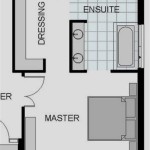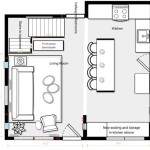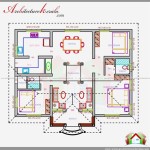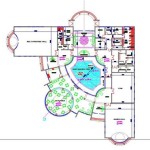Most Energy Efficient Home Floor Plans
Energy efficiency has transitioned from a niche concern to a mainstream priority for homeowners and builders alike. The design of a home's floor plan exerts a significant influence on its energy consumption, dictating factors such as natural light penetration, heating and cooling requirements, and ventilation strategies. Choosing an energy-efficient floor plan is a critical step towards reducing utility bills, minimizing environmental impact, and enhancing the overall comfort and sustainability of a dwelling.
This article will delve into the key features and considerations associated with developing energy-efficient home floor plans. It will explore various design principles and practical strategies that can be implemented to optimize energy performance across a range of architectural styles and climates. Understanding these elements is crucial for anyone seeking to construct or renovate a residence with a focus on sustainability and long-term cost savings.
Optimizing Orientation and Natural Light
A fundamental aspect of energy-efficient home design is the strategic orientation of the building on the lot. Solar orientation, in particular, plays a vital role in maximizing passive solar heating during the winter months and minimizing excessive solar gain during the summer. In the Northern Hemisphere, orienting the long axis of the house along an east-west axis typically provides optimal exposure to the sun’s path throughout the day. This allows for strategically placed windows to capture solar energy in the winter, reducing reliance on artificial heating systems.
South-facing windows are particularly effective for passive solar heating. In winter, the lower angle of the sun allows sunlight to penetrate deep into the home, warming interior spaces. Overhangs or awnings can be used to shade these same windows during the summer months, preventing excessive heat gain. East-facing windows, while beneficial for morning sunlight, can contribute to overheating in the afternoon, especially in warmer climates. West-facing windows, similarly, can result in significant heat gain during the hottest part of the day. Careful consideration should be given to the size and placement of windows on these facades to minimize unwanted solar heat gain.
Beyond orientation, the strategic use of natural light is crucial for reducing reliance on artificial lighting. Maximizing daylight penetration can significantly lower electricity consumption, particularly during daytime hours. This can be achieved through the use of larger windows, strategically placed skylights, and light-reflecting interior surfaces. Light wells and interior courtyards can also be incorporated into the floor plan to bring natural light into areas that might otherwise be dark and require constant artificial illumination. The depth of rooms should also be considered; shallower rooms allow for better natural light penetration than deep rooms.
Furthermore, the selection of window glazing plays a crucial role in managing solar heat gain and heat loss. Low-emissivity (low-E) coatings can reduce heat transfer through windows, improving energy efficiency in both heating and cooling seasons. Double-pane or triple-pane windows with insulated frames provide superior thermal performance compared to single-pane windows, reducing heat loss in winter and heat gain in summer. Window shading devices, such as blinds, curtains, and solar screens, can further enhance energy efficiency by controlling the amount of sunlight entering the home.
Compact Design and Thermal Zoning
The overall footprint and layout of a home directly influence its energy efficiency. Compact designs, which minimize the surface area exposed to the exterior environment, are inherently more energy-efficient than sprawling layouts. A smaller surface area reduces heat loss in winter and heat gain in summer, lowering the demand for heating and cooling. Multi-story homes, in particular, tend to be more energy-efficient than single-story homes of the same square footage due to their reduced roof and foundation exposure.
Beyond compactness, the concept of thermal zoning is a critical consideration in energy-efficient floor plan design. Thermal zoning involves dividing the home into distinct heating and cooling zones based on usage patterns and environmental factors. For instance, bedrooms, which are primarily used during the night, can be zoned separately from living areas, which are primarily used during the day. This allows for customized temperature control in each zone, preventing unnecessary heating or cooling of unoccupied spaces. Programmable thermostats and multi-zone HVAC systems are essential components of a thermal zoning strategy.
Proper insulation is fundamental to effective thermal zoning. Walls, ceilings, and floors should be adequately insulated to minimize heat transfer between different zones and between the interior and exterior environments. The level of insulation required varies depending on the climate, with colder climates requiring higher R-values (a measure of thermal resistance). Air sealing is equally important to prevent air leakage, which can significantly compromise the effectiveness of insulation. Sealing cracks, gaps, and penetrations around windows, doors, and other building components can dramatically reduce energy waste.
The placement of buffer zones, such as garages, closets, or storage rooms, can also contribute to thermal zoning. These spaces can act as thermal barriers, buffering the living areas from extreme temperatures. For example, a garage located on the north side of the house can help to insulate the adjacent living spaces from cold winter winds. Similarly, a well-insulated attic can act as a buffer zone, reducing heat gain in the summer and heat loss in the winter.
Strategic Placement of Living Spaces and Building Materials
The arrangement of living spaces within the floor plan can significantly impact energy efficiency. Frequently used areas, such as living rooms and kitchens, should be located in areas with optimal access to natural light and passive solar heating. Less frequently used areas, such as bedrooms and bathrooms, can be placed in areas with less ideal solar exposure.
In colder climates, it is often advantageous to locate living spaces on the south side of the house to maximize solar gain. Bedrooms can be placed on the north side, where they will remain cooler during the summer months. In warmer climates, the opposite approach may be more appropriate, with living spaces located on the north side to minimize solar heat gain and bedrooms located on the south side to capture breezes.
The choice of building materials also plays a significant role in energy efficiency. Materials with high thermal mass, such as concrete, brick, and stone, can absorb and store heat, moderating temperature fluctuations and reducing the need for artificial heating and cooling. These materials are particularly effective in climates with significant temperature swings between day and night.
Reflective roofing materials can reduce solar heat gain, especially in warmer climates. Light-colored roofing materials reflect a significant portion of the sun’s energy, preventing it from being absorbed into the building. This can significantly lower cooling costs, particularly during the summer months. Similarly, light-colored exterior walls can reduce heat gain compared to dark-colored walls.
Sustainable and locally sourced building materials can also contribute to overall energy efficiency by reducing the energy required for transportation and manufacturing. Materials such as reclaimed wood, recycled content insulation, and sustainably harvested lumber can minimize the environmental impact of the building process. Furthermore, the use of low-VOC (volatile organic compound) paints and finishes can improve indoor air quality, reducing the need for mechanical ventilation and lowering energy consumption.
Finally, consider the layout of the home in relation to prevailing winds. Natural ventilation can significantly reduce the need for air conditioning, especially in climates with moderate temperatures. Orienting the house to capture prevailing breezes and providing cross-ventilation pathways can create a comfortable indoor environment with minimal energy consumption. Operable windows and strategically placed vents can facilitate airflow throughout the home.

Energy Efficient Home Design Plans Cad Pro

How To Build An Energy Efficient Home

Infographic What Makes A Net Zero Energy Home So Efficient House Homes Saving

Eco Friendly Home Familly House Minimalist Design
Energy Efficient Home Building

Anatomy Of A Net Zero Home Energy Efficient House Design Sustainable Plans

How Do We Define Net Zero Energy More Importantly Can Work Towards As A Standard Build Team Blog

Energy Efficient Houses By Blu Homes Cut Owners Electricity Bills 50 70 Greener Ideal

Concept For Energy Efficient House Plans Efficiency Design

20 Ways To Make Your Home More Energy Efficient Terra Therma

